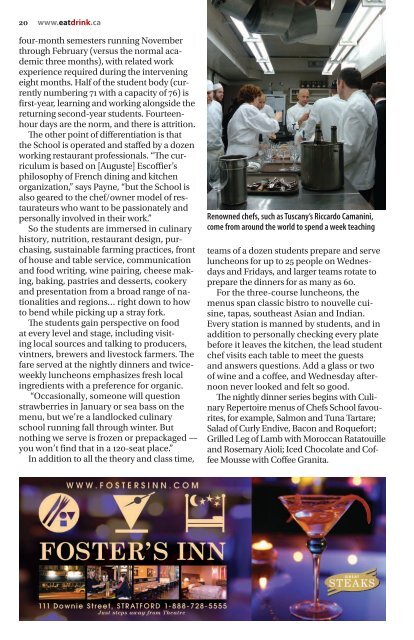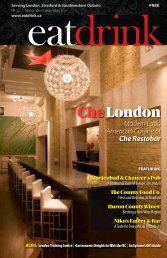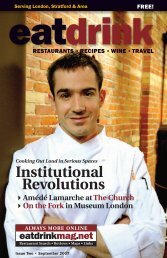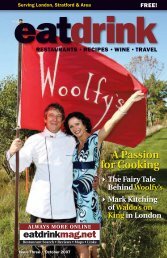Charleston Cooks! - eatdrink Magazine
Charleston Cooks! - eatdrink Magazine
Charleston Cooks! - eatdrink Magazine
You also want an ePaper? Increase the reach of your titles
YUMPU automatically turns print PDFs into web optimized ePapers that Google loves.
20 www.<strong>eatdrink</strong>.ca<br />
four-month semesters running November<br />
through February (versus the normal academic<br />
three months), with related work<br />
experience required during the intervening<br />
eight months. Half of the student body (currently<br />
numbering 71 with a capacity of 76) is<br />
�rst-year, learning and working alongside the<br />
returning second-year students. Fourteenhour<br />
days are the norm, and there is attrition.<br />
�e other point of di�erentiation is that<br />
the School is operated and sta�ed by a dozen<br />
working restaurant professionals. “�e curriculum<br />
is based on [Auguste] Esco�er’s<br />
philosophy of French dining and kitchen<br />
organization,” says Payne, “but the School is<br />
also geared to the chef/owner model of restaurateurs<br />
who want to be passionately and<br />
personally involved in their work.”<br />
So the students are immersed in culinary<br />
history, nutrition, restaurant design, purchasing,<br />
sustainable farming practices, front<br />
of house and table service, communication<br />
and food writing, wine pairing, cheese making,<br />
baking, pastries and desserts, cookery<br />
and presentation from a broad range of nationalities<br />
and regions… right down to how<br />
to bend while picking up a stray fork.<br />
�e students gain perspective on food<br />
at every level and stage, including visiting<br />
local sources and talking to producers,<br />
vintners, brewers and livestock farmers. �e<br />
fare served at the nightly dinners and twiceweekly<br />
luncheons emphasizes fresh local<br />
ingredients with a preference for organic.<br />
“Occasionally, someone will question<br />
strawberries in January or sea bass on the<br />
menu, but we’re a landlocked culinary<br />
school running fall through winter. But<br />
nothing we serve is frozen or prepackaged —<br />
you won’t �nd that in a 120-seat place.”<br />
In addition to all the theory and class time,<br />
DECEMBER/JANUARY 2010<br />
Renowned chefs, such as Tuscany’s Riccardo Camanini,<br />
come from around the world to spend a week teaching<br />
teams of a dozen students prepare and serve<br />
luncheons for up to 25 people on Wednesdays<br />
and Fridays, and larger teams rotate to<br />
prepare the dinners for as many as 60.<br />
For the three-course luncheons, the<br />
menus span classic bistro to nouvelle cuisine,<br />
tapas, southeast Asian and Indian.<br />
Every station is manned by students, and in<br />
addition to personally checking every plate<br />
before it leaves the kitchen, the lead student<br />
chef visits each table to meet the guests<br />
and answers questions. Add a glass or two<br />
of wine and a co�ee, and Wednesday afternoon<br />
never looked and felt so good.<br />
�e nightly dinner series begins with Culinary<br />
Repertoire menus of Chefs School favourites,<br />
for example, Salmon and Tuna Tartare;<br />
Salad of Curly Endive, Bacon and Roquefort;<br />
Grilled Leg of Lamb with Moroccan Ratatouille<br />
and Rosemary Aioli; Iced Chocolate and Coffee<br />
Mousse with Co�ee Granita.





